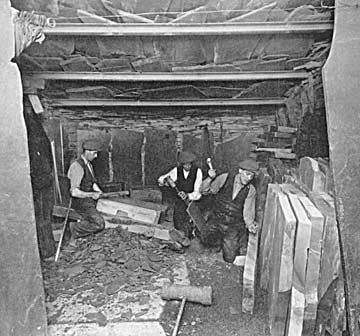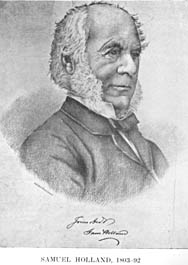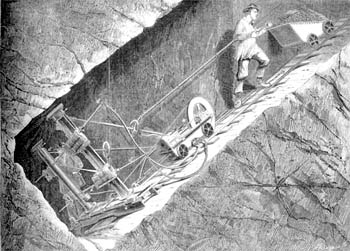Quarry Proprietors - The Welsh and English
Entrepreneurs
Outsiders from England
William Turner (1766-1853) was born at Seathwaite,
Leicestershire to a local quarry owner. In 1800, he formed a
partnership with William and Thomas Casson from
Cumberland. (Thomas would go on to found Casson’s Bank.) Turner lived at Plas Brereton, Caernarfon, whilst
George and William Casson, his sons lived at
Blaenyddol, Llan Ffestiniog. Hugh Jones, a banker from
Dolgellau joined them in due course, the company being known as
William Turner & Co. and later as the Diphwys
Casson Slate Co. This was only a part of the vast development
that saw twenty-seven quarries working in Blaenau Ffestiniog by
1881. (It is also interesting to note that William Turner and
Hugh Jones joined Thomas Assheton Smith and Thomas
Wright to operate the Dinorwig Quarry, Llanberis, in 1809. Indeed Turner
was to be responsible for running many quarries.
 Another
important figure in the Ffestiniog Slate Quarrying era was
Samuel Holland the younger (1803-92), pictured right. His
father, Samuel Holland the elder, (1768-1851) was involved
in the lead, copper and slate industry in North Wales, and was
also a prominent slate merchant for Penrhyn Quarry in the early
1800s. Samuel the son was educated in England and Germany before
joining his father’s company as an office boy. At eighteen years
old, his father sent him to Blaenau Ffestiniog to take charge of
the Rhiwbryfdir Quarry. He subsequently became an important
figure in the company. It was his idea to build a railway from
Blaenau to Porthmadog, where he set up a Savings Bank in 1845. He
was responsible for founding many Book Clubs, elementary schools,
as well as the Dr. Williams School for Girls at Dolgellau in
1875. Elected as High Sheriff in 1862, he then represented the
county in Parliament as a Liberal from 1870 to 1885. Apart from
all this, he was also very interested in farming and reared
between fifteen hundred and two thousand sheep on the
mountainsides by Rhiwbryfdir. Both farm and quarry prospered.
Indeed, as early as 1852 he had installed gaslight underground and
had developed slate dressing machines. Elizabeth Gaskell, the
Victorian novelist was a cousin to him. Another
important figure in the Ffestiniog Slate Quarrying era was
Samuel Holland the younger (1803-92), pictured right. His
father, Samuel Holland the elder, (1768-1851) was involved
in the lead, copper and slate industry in North Wales, and was
also a prominent slate merchant for Penrhyn Quarry in the early
1800s. Samuel the son was educated in England and Germany before
joining his father’s company as an office boy. At eighteen years
old, his father sent him to Blaenau Ffestiniog to take charge of
the Rhiwbryfdir Quarry. He subsequently became an important
figure in the company. It was his idea to build a railway from
Blaenau to Porthmadog, where he set up a Savings Bank in 1845. He
was responsible for founding many Book Clubs, elementary schools,
as well as the Dr. Williams School for Girls at Dolgellau in
1875. Elected as High Sheriff in 1862, he then represented the
county in Parliament as a Liberal from 1870 to 1885. Apart from
all this, he was also very interested in farming and reared
between fifteen hundred and two thousand sheep on the
mountainsides by Rhiwbryfdir. Both farm and quarry prospered.
Indeed, as early as 1852 he had installed gaslight underground and
had developed slate dressing machines. Elizabeth Gaskell, the
Victorian novelist was a cousin to him.
John Whitehead Greaves (1807-80) was born the third son
of John Greaves, a Quaker and banker from Radford, Warwickshire.
His grew up into a wandering adventurer, having postponed his
intention to sail as an immigrant to Canada from Caernarfon in
around 1830, decided to go into partnership with Edwin
Shelton, from Grimley, Worcestershire. Together they took a
‘take-note’ (short term exploratory option) at the Glynrhonwy
Quarry, Llanberis; a quarry that had been worked since 1804 and
had recently bankrupted one lessee, John Roberts of Liverpool to
the sum of thirty thousand pounds. Roberts had also been lessee
to Lord Newborough of the Bowydd Quarry at Blaenau Ffestiniog.
Having taken both quarries on a twenty-one year lease, Shelton
took charge at Glynrhonwy and Greaves at Bowydd. This was a
period of unprecedented industrial growth, which saw the founding
of the North and South Wales Bank, (taken over by Midland
in 1908) and also the building of the Ffestiniog Railway, to
which Greaves acted as treasurer from 1843-47 and as chairman
from 1843-47 and 1850-57. 1842 was also the year of the Great
Fire of Hamburg, which created a huge demand for Welsh slate.
Greaves soon realised that there had to be an abundance of
slate under Llechwedd y cyd, the land that separated the
Bowydd and Foty Quarries from the Rhiwbryfdir Quarry. He formed a
partnership with the second Lord Newborough and William
Edward Oakeley. But the prolonged search for the Merioneth
Old Vein nearly destroyed Greaves financially before he
struck the elusive slate deposits in 1849. Like Holland, he
developed slate machinery, and in 1851 enhanced the name of
Llechwedd Slate by winning a Class 1 Prize Medal at the Great
Exhibition. The order books began to bulge and he was awarded a
contract the following year to supply slates for Kensington
Palace. Another medal would be won at the London Exhibition in
1862 and at the Paris Exhibition in 1867. He also branched into
the shipbuilding industry at Porthmadog. Edwin Shelton had died
in 1848, but Greaves carried on working Glynrhonwy until 1862,
though not surrendering the lease until 1873.
John Ernest Greaves (1847-1945) was born at
Tan-yr-allt, Tremadog but spent most of his childhood at
Llechwedd, being educated at schools in Warwickshire, Edinburgh
and Dorset before going to Oxford. On coming down in 1870, his
father left him to manage Llechwedd and to live ‘on site’ at Plas
Weunydd. In 1874 he was one of the founder members of the Madoc
Lodge No 1509 of Free and Accepted Masons. Five years later he
married Marianne Rigby, a granddaughter of Samuel Darbyshire,
owner of the Penmaenmawr Granite Quarries. With his increasing
wealth he began to build properties and own land on both sides of
the then county boundary, being appointed a Justice of the Peace,
High Sheriff and Deputy Lieutenant for Meirionydd in 1884, High
Sheriff for Caernarfonshire in 1885, and a Justice of the Peace
and Lord Lieutenant of the county in 1886. The previous year he
handed over the role of general manager at Llechwedd to his
brother Richard Methuen Greaves, though remaining as
chairman of the syndicate. He also served as chairman of the
Caernarfonshire Quarter Sessions from 1890-1929 and as chairman
of the County Council in 1906.
In 1900, the three brothers, J.E. Greaves, R.M. Greaves
and Edward Seymour Greaves together with their respective
wives formed themselves into a limited company. Winning the gold
medal at the Buenos Aires World Fair in 1910, brought in many
valuable South American orders. It was also decided the following
year to offer the job of general manager and engineer to
Martyn Williams-Ellis (1885-1968), grandson to J.W.
Greaves. The Great War prevented him taking up the post as
intended in 1914, but his impact was immediate after 1918, when
he decided to undertake a complete process of modernisation and
mechanisation, which transformed the outlook at Llechwedd. In
1931, the company decided to buy out the grazing rights of the Tanybwlch and Glynllifon and proceeded in 1936 to untop the mine
in order to gain access to the pillars of first class slate left
to act as supporting pillars since Victorian times. Llechwedd was
fast becoming an efficient operation with great potential.
George Whitehead Greaves (1889-1953) became chairman in
1945. But after his untimely death in 1953, in mysterious
circumstances during the Mau Mau revolt, Martyn
Williams-Ellis was appointed Chairman and managing Director.
He undertook the untopping scheme in 1931 so as to improve quarry
production. He was succeeded by his son John
Williams-Ellis (b.1923) As has been noted already, Llechwedd, under the Greaves Group of Companies, is a thriving
business geared to industrial and tourist needs.
Sir Haydn’s political expediency
One of the longest serving Liberal Members of Parliament
representing a Welsh constituency at Westminster, during the
twentieth century, apart from David Lloyd George, was Sir Henry Haydn Jones (1863-1950).
He lived at Pantyneuadd, Tywyn, and
held the seat of Meirionydd from 1910 until his retirement in
1945. A son of the minor Welsh composer J.D. Jones (1827-70), he
was brought up at Rhuthun where his father set up the exceedingly
anglophile private grammar school of Clwyd Bank. Educated at
Tywyn, he was adopted by his uncles and set up in business by them
as a hardware merchant at 22 High Street, Tywyn. In 1903 he
married Barbara, daughter to Lewis D. Jones, who was originally
from Tywyn but had emigrated to the U.S.A, and set up as an
ironmonger and quarry owner in Chicago. As a politician he was
not a roaring success, but he did edit a collection of hymns and
hymn tunes which was published in 1910 under the title Cân a
Moliant. He was knighted in 1937. Slate Quarrying at
Abergynolwyn dated back to the 1840’s but by 1909, due to the
quarrying of all the best rock and the lack of capital
investment for many years it was in decline. As a newly elected M.P., Haydn Jones’s attempted to find a buyer for the
Abergynolwyn Quarry, but with no success. In January 1911, he
bought the quarry, village and the Tal-y-llyn Railway himself for
five thousand, two hundred and fifty pounds using borrowed
capital. Before the end of the year, the Abergynolwyn Slate
and Slab Company Limited had been formed with Haydn Jones as
sole director. In 1935 he purchased the lease on the Aberllefenni
Quarry. In 1956 the company changed its name to the
Aberllefenni Slate Quarries Limited and was still trading
under that name in 1999.
A post war boom was experienced at Abergynolwyn, but it was
short-lived. In December 1939 there was a serious cave in, but
fortunately without loss of life. Production ceased in 1946. The
Tal-y-llyn Railway first opened in 1865 still continues to run as
a tourist attraction.

|